Vegan ricotta (2 ingredients)

This is a simple vegan ricotta recipe that I’ve been meaning to share for ages, but I could not get round to it. I finally went through the process of writing it all down and taking photos to guide you in this ricotta making process. I hope you’ll give it a go.
It’s a really simple, 2 ingredient (3 if you count the salt), vegan ‘cheese’ that borrows from a traditional ricotta making process. It relies on curdling high percentage almond milk with the help of acid until it splits into what is known in traditional ricotta making as whey and milk curds. Although it is possible to make it without a kitchen thermometer – in fact my first few attempts were done without one and they all succeeded – I recommend you get one especially if this is your first time curdling (almond) milk.
I used Serious Eats recipe and tried to keep my almond milk in the prescribed temperature range of 79-88°C (175°F-190°F), but don’t panic if there are times when your almond milk drops below that bottom temperature or climbs a little higher either. It happened to me a bunch of times when photographing the process because ‘hello, singlehandedly photographing and doing technically challenging cooking at the same is difficult!’ (that’s a note to my inner critic who is obviously not happy about some of my photos – well, I am going to go ahead and publish them anyway!) and it still turned out fine.
If you want a less involved process, another – more straightforward – method is to warm the milk up a little higher (93°C / 199°F), add acid and let it rest once it starts to curdle. It worked well for me too, but I prefer the first method a little more.
MORE ABOUT THE INGREDIENTS

ALMOND – almonds form the base of this cheese. I used blanched almonds, but you could use unblanched or slivered almonds if you prefer. I have tried using sunflower seeds to create a nut-free version, but it didn’t quite work for me so I have nothing to show for my attempt sadly. I might revisit it at some point.
LEMON JUICE – lemon juice is what helps almond milk to curdle when heated. You could use distilled white vinegar, but if you do use less 10 ml / 2 tsp should be enough to curdle this amount of almond milk.
SALT – salt is an optional ingredient and it isn’t instrumental to the process at all. If you plan on using this ricotta in a savoury context, I like to add ½ tsp of sea salt, but you may find it too much or too little so best to experiment and adjust the level of salt to your taste. I recommend adding just a pinch of salt to your first ricotta and seasoning afterwards if needed.
I DON’T HAVE A RICOTTA MOULD…
If you don’t have a ricotta mould, that’s perfectly fine. You could use a single muslin cloth lined sieve, for example. Any container with plenty of drainage holes will do the job.
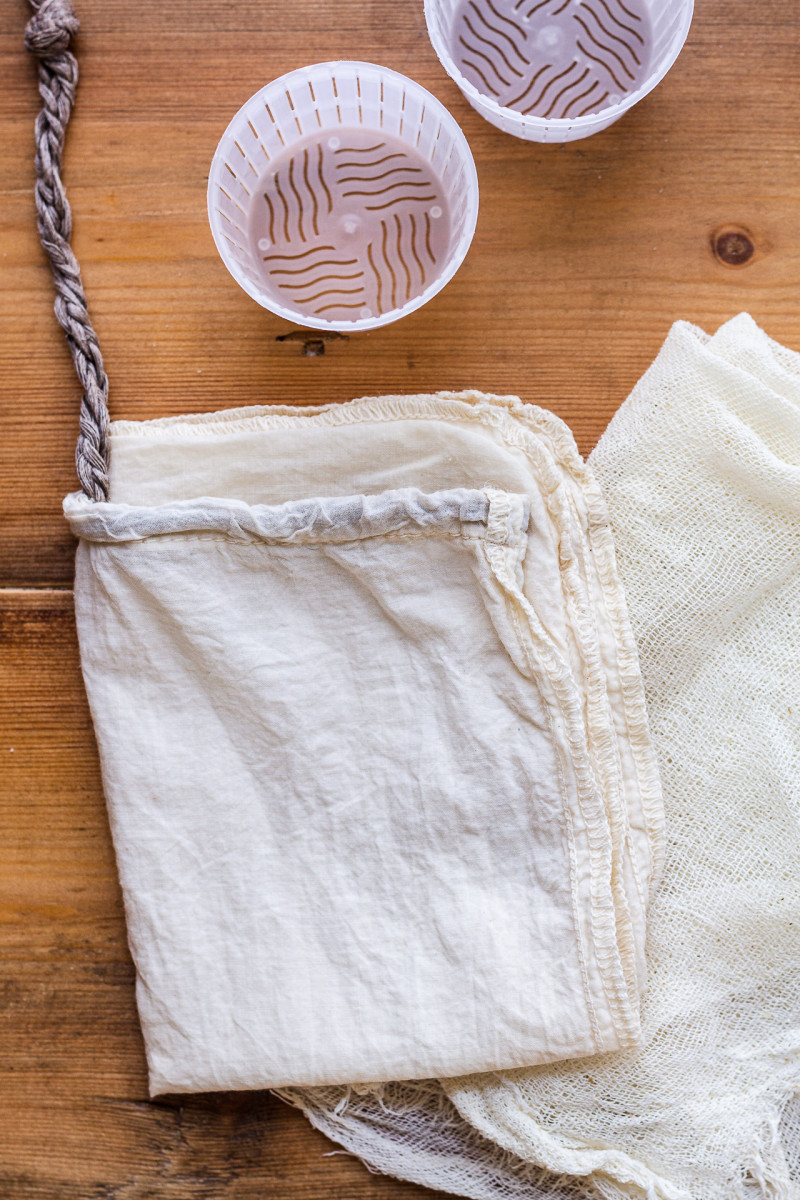
WHAT ABOUT LEFTOVER PULP?
If you hate food waste, you are in good company! I hate it too! ‘So what do you do with leftover almond pulp?’ you ask. I spread it on a large baking tray and air dry it or dry out in the sun (or low oven in winter). Once completely dry, I pop it into a food processor to grind up finely. I store it in an air-tight container and use like I would almond flour. It’s great in baking – I add it to muffins and tart crusts (some extra moisture may be needed) and add it to ‘meatballs’ for example. If you don’t want to go to the trouble of drying and pulverising it, use it as it is to make these or other muffins and cakes.
HOW DO YOU USE IT?
I like dotting it on top of pasta, gnocchi or salad. I also like to spread it on crackers or sourdough. You can use it in baked dishes too. I recently baked it on top of pizza and it worked really nicely, adding a much needed creamy element. It is very mild in flavour so it does well in all kinds of dishes, both savoury and sweet.
HOW LONG DOES IT KEEP?
I found that it keeps for almost a week (5-6 days) in an air-tight container in the fridge. I also tried freezing it and it freezes well enough although it certainly isn’t as good as fresh. Once defrosted, the consistency changes – individual curds are more discernible, ricotta becomes less creamy and uniform.
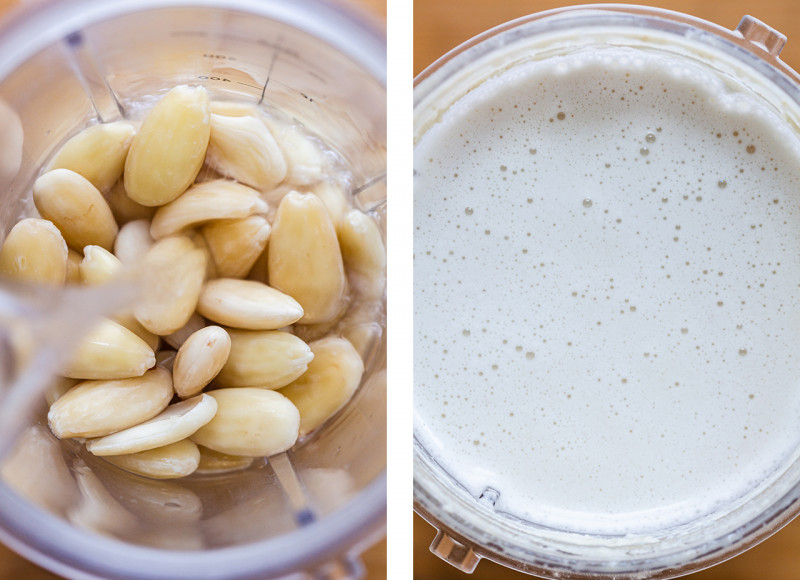
Blend softened (soaked for minimum 4 hours) almonds with water until almonds are very finely ground and the water turns into rich almond milk.
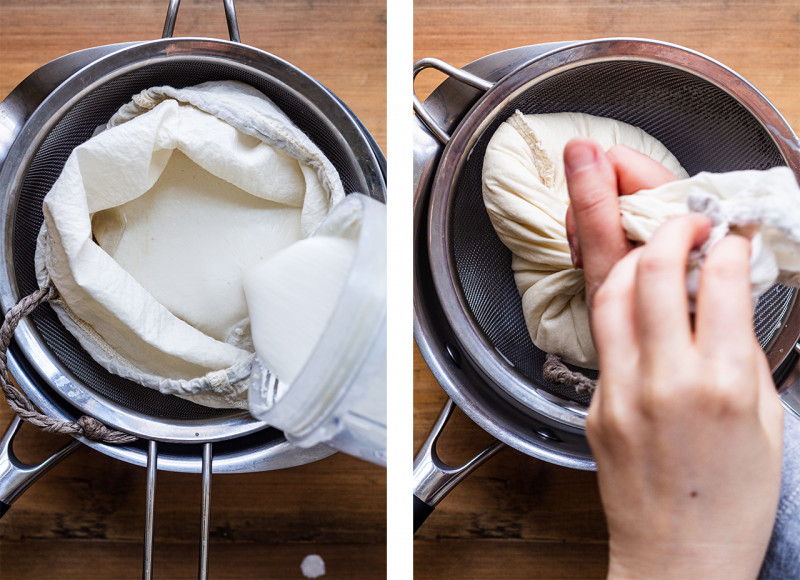
Separate the milk away from the pulp using a nut bag or a double layered muslin cloth and applying pressure.
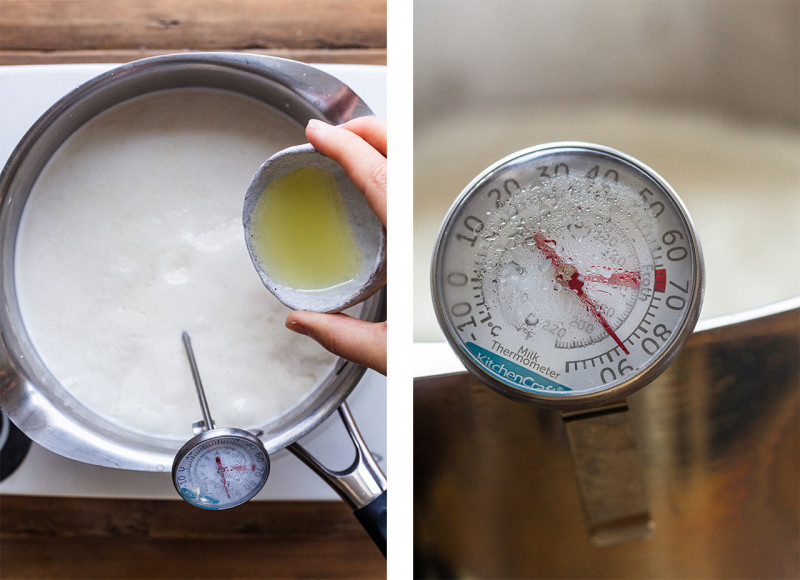
Bring almond milk to 85°C / 185°F or 93°C / 199°F if you want a speedier method – both work, but I prefer the results of the former. Once the milk reaches correct temperature, add the acid and stir gently to ensure distribute the acid evenly. Either rest (if you opted for the speedier method) or carry on simmering the milk for 20 minutes, maintaining it with the 79-88°C / 175°F-190°F temperature range.

Rest for 10-15 minutes after taking off the heat then, using a spoon, gently transfer the curds that separated from the milk into a ricotta mould or a muslin cloth lined sieve. Allow ricotta to set and for the excess moisture to drain away for at least 8 hours.
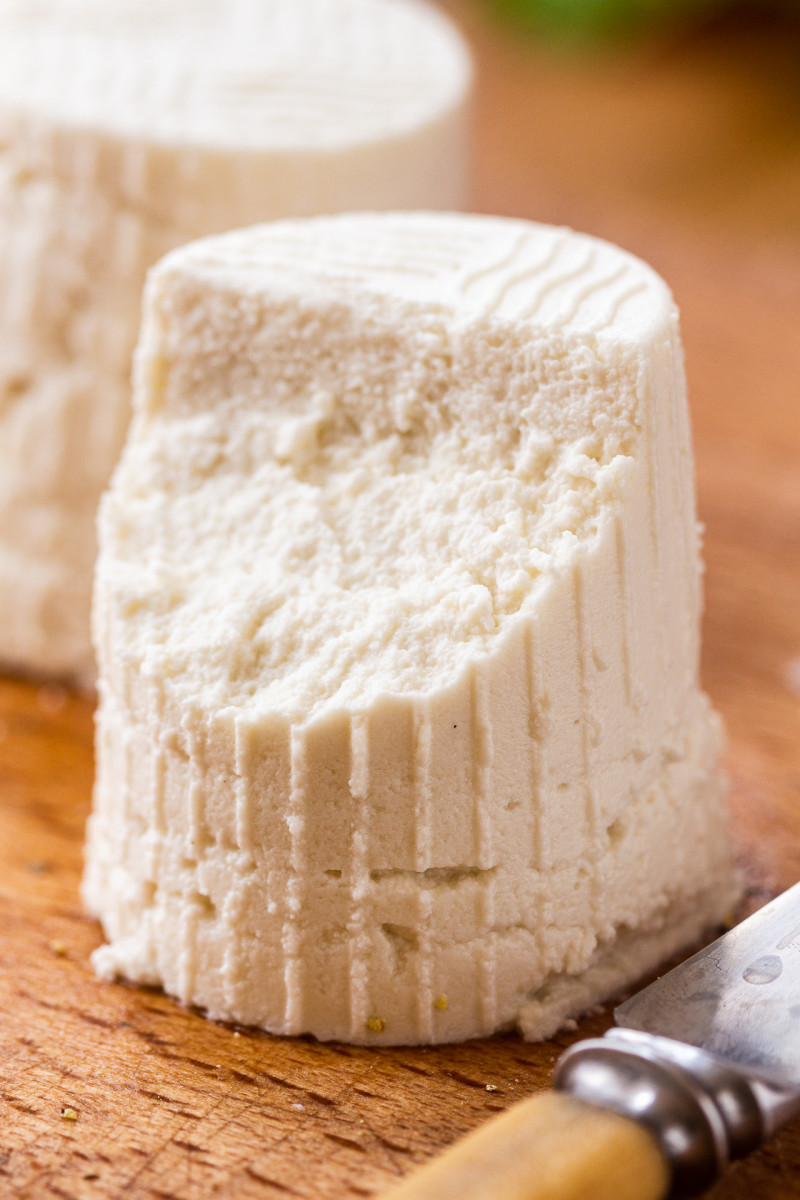

- 200 g / 7 oz raw almonds*, blanched or unblanched
- 20-30 ml / 4-6 tsp lemon juice*
- salt, optional
- Soak almonds in cold water for 4-8 hours or overnight. Drain, discard the water.
- Place drained almonds in a blender with 600 ml / 2½ cups of fresh water. If you are using a small blender, only use as much water as it fits in the blender and add the rest directly to the pot in step 5.
- Blend until almonds are really finely ground and the water turns into creamy almond milk.
- Place a nut bag (or a double layered muslin cloth) in the sieve suspended over a medium-large pot.
- Gradually pour the contents of blender into the nut bag and allow the milk to drain into the pot below.
- Once most of the liquid drains out, squeeze the nut bag really well to extract as much milk as you can – you should be left with super dry pulp (see blog post above for ideas to use it up).
- If using salt, add it to the pot and mix well to dissolve.
- Bring almond milk to a gentle simmer, until a thermometer registers 85°C / 185°F. If you want to expedite the process and not have to simmer it for 20 minutes after adding lemon juice, allow the milk to come to 93°C / 199°F instead.
- Once your almond milk comes to temperature, sprinkle 20 ml / 4 tsp lemon juice on the surface of the simmering milk. Stir gently to distribute the acid evenly. You should see small curds forming after a couple of minutes. If the milk isn’t curdling, add a little more lemon juice.
- This is the point where you could simply rest curdled milk for 10 minutes and transfer the curds to a mould, but I got a nicer end product by simmering it for another 20 minutes and resting – see next step.
- Keep the pot on low heat and aim to maintain 85°C / 185°F for full 20 minutes without stirring. Try to keep the milk within 79-88°C / 175°F-190°F range.
- You should end up with delicate curds by the end of this process – I found that the separation isn’t always as visually apparent as it is with dairy milk and sometimes the milk just looks thick and creamy but that’s okay the resulting cheese is still delicious. Rest the milk for 10 minutes.
- Place a mould/moulds on a deep plate so that any excess liquid can drain away. Gently transfer the curds to the mould (see the post for alternatives).
- Keep in the fridge overnight to set. The longer it sets the firmer it will get, but I find that it needs at least an overnight stay in the fridge to firm up enough to use.
- Keep ready ricotta in an air-tight container in the fridge, for 5-6 days. It can be frozen, but it will release some liquid once defrosted – simply drain it away and use. It’s perfect spread of toast/crackers, crumbled on top of pasta/gnocchi/risotto or on top of pizza.
*LEMON JUICE: I find that lemons vary when it comes to their acidity so if your almond milk isn’t curdling, you may have to use more lemon juice. Alternatively vinegar – apple cider vinegar or distilled white vinegar instead can also be used but you won’t need as much, 20 ml / 4 tsp should be enough.
*SALT: it’s an optional ingredient that isn’t necessary for the process. If you are making it for the first time, I recommend just adding a good pinch and seasoning to taste afterwards. I use ½ tsp of fine sea salt, but it may be too much or too little for your taste so it’s best to experiment.
The method has been adapted from this dairy ricotta recipe.

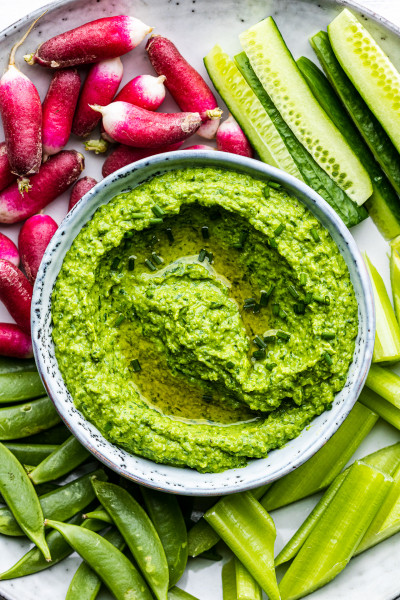

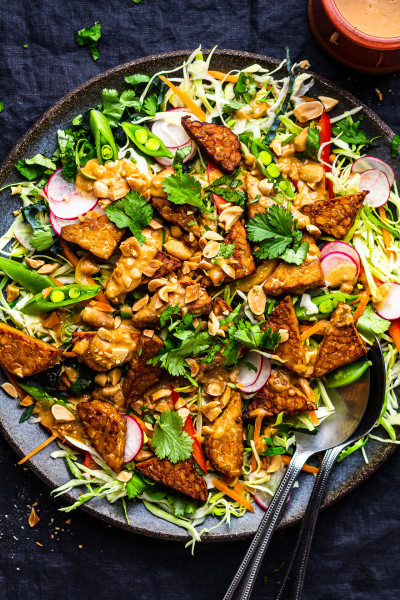
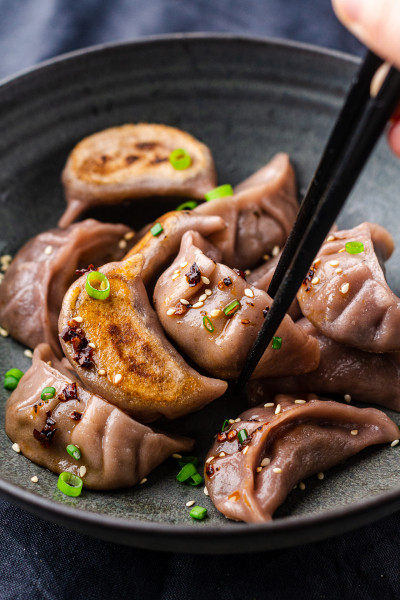

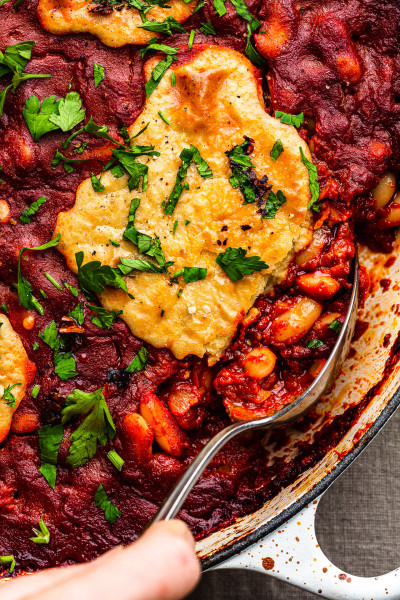
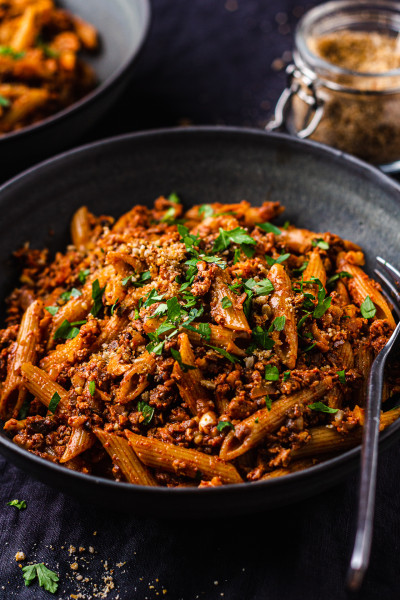
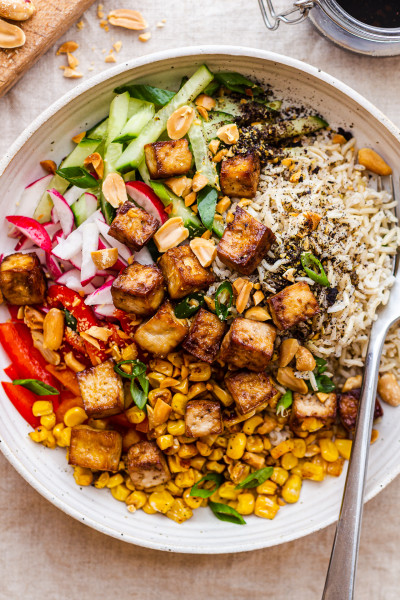
This is a wonderful recipe, i made it half almond half soya as you suggested in the notes, , it is so delicate and delicious, thank you, I am going to try the almond feta next,
Enjoy the weekend
Jenn
Thank you for this and so many wonderful vegan recipes, I am going to give it a go today, one question please, when you talk about subbing soya milk is that to replace half the water is it still 600ml fluid in total? Please excuse if I’m being “thick”!!!
Thank you for your time
Jenn
You are very welcome, I am delighted that my recipes are serving you well. What I mean is to use 600 ml liquid in total, half of that would be soy milk, half water and only 100 g (3.5 oz) of almonds. So basically 300 ml soy milk replaces 300 ml of water and 100 g of almonds. Hope this makes sense. Ania
Can I make this cheese with shop bought almond milk?
Thanks
Thank you! I'll definitely share my results with you.
this is the first vegan cheese recipe I´m trying and it looks very promising! I'm a digital nomad nad I tend to not buy a lot of gadgets! lol. Can I do it If I don´t have a thermometer by the looks of it? or is it very recommended?
Sure you can, in fact I usually just make it by feel. You simply need to bring the milk to just before the boiling point (about 93°C / 199°F) before sprinkling in acid, give it a gentle stir and then just wait. The curds will form, they may be smaller than what you expect but that doesn't matter - the cheese will still be delicious once it drains and sets. Hope this helps. x Ania
Thank you for this recipe. I tried it before as part of a vegan cheese-making course, and we loved it. Your blog reminded me of it. So now I want to make it again.
I have a question: can you do anything with the "whey", the liquid that drips away from the mold? Could it be used in protein shakes or pancake batter, as is always suggested about dairy milk whey? I look forward to reading your ideas.
I thought it tasted too cashew-y and lemony but it worked so well in lasagne.
The cheese didn't freeze very well though, it came out tough and grainy. But I wouldn't say it was a big deal. Still delicious.
I made a smaller batch with almonds and I liked the taste a lot better. I only wish I couldn't notice the lemon as much.
I also love how clear the steps and tips are. It was like walking me through the process and it was impossible to mess up.
Thanks for this wonderful recipe :)
Yes, I am pretty sure they will work the same. Use the same amount by weight. Hope this helps! x Ania
Anyway, it turned into a delicious cream cheese and I can see how versatile it is! Genius idea :)
Quick question for next time: What happens if you go beyond 93°C? Have you every tried?
If you mean shop bought, I doubt it will work very well as they tend to be really watered down, but I could be wrong. The point of making your own almond milk here is that you want it rich and that richness (fat) becomes cheese. Hope this helps! Ania
Yes, it does work nicely on pizza - in fact, I am making one for the blog as we speak :) Hope you'll give it a go, it's really simple to make too. Ania